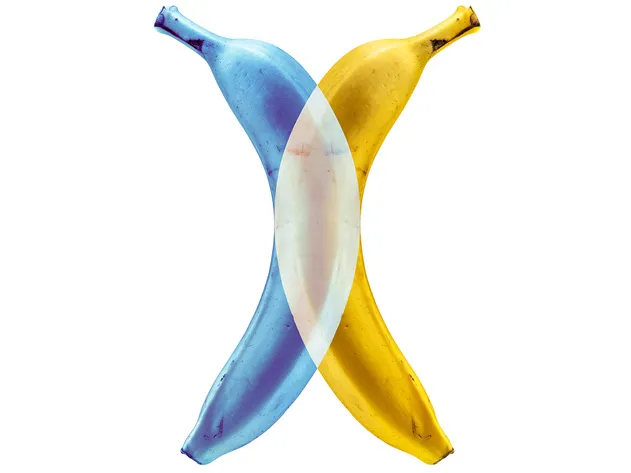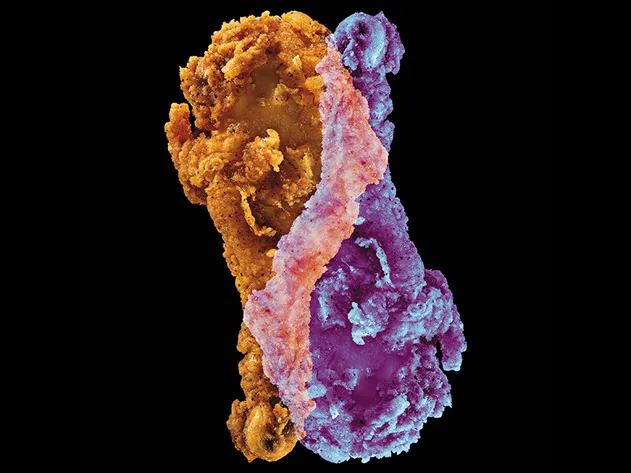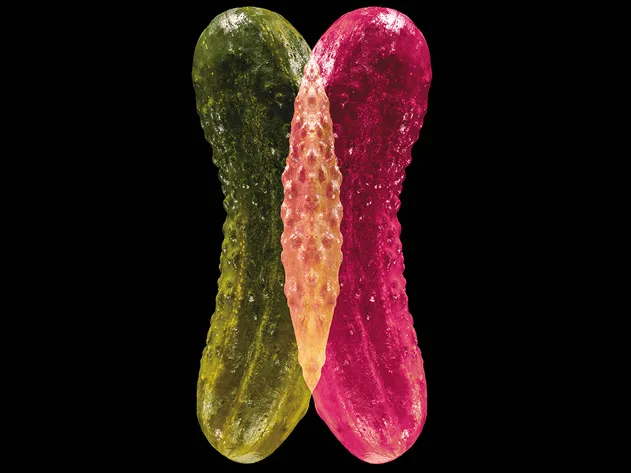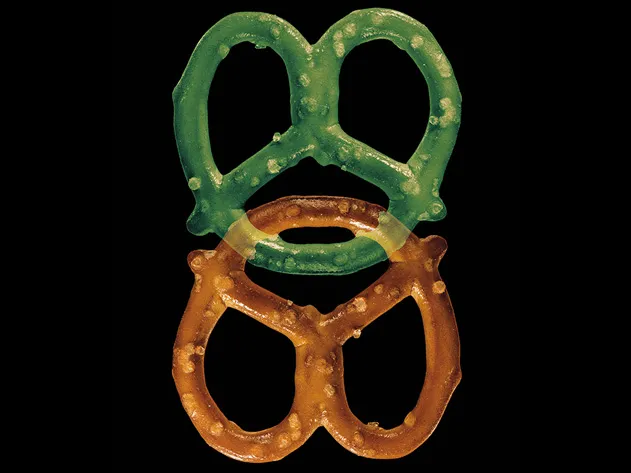Why You Like What You Like
Researchers are cooking up experiments to learn what might explain which foods we love and which foods we hate
/https://tf-cmsv2-smithsonianmag-media.s3.amazonaws.com/filer/Accounting-for-Taste-fried-chicken-banana-631.jpg)
For most of us, a pickle is a pickle. It is something that rests snugly beside a sandwich, or floats in a jar on a deli counter. It is rarely something that occasions cryptographic analysis. A number of years ago, though, Howard Moskowitz, a Harvard-trained psychophysicist and food industry consultant, was asked by Vlasic Pickles to crack “the pickle code.” Losing market share to Claussen, the Vlasic executives wanted to take a hard look at a question that was, surprisingly, rarely asked: What kind of pickles did people really want?
Sitting in the wood-paneled Harvard Club in Midtown Manhattan, where he can often be found, Moskowitz tells me how, at Vlasic’s behest, he stopped in Detroit to take part in a brine-tasting experiment in the airport’s Admirals Club. “We came out with an experimental design of 45 different combinations of garlic, salt, spices and oils,” he says. The test prompted the executives to come up with pickles that were far different from the current offerings. It forced them to think outside the jar.
What was most surprising, says Moskowitz, is that many people in later taste tests seemed to gravitate to pickles that were spicier than what Vlasic sold. “You could relate the ingredients and their interactions by a mathematical model to the amount of liking,” he says. “So you had an optimum pickle.”
And when Vlasic subsequently released its line of “zesty” pickles, he says, “you had the best-selling thing in history. We didn’t expect that.”
That people in the pickle business should not know what pickle consumers prefer is a reminder of just how difficult it is to tease out the vagaries of why we like what we like, something Moskowitz has been trying to think analytically about his entire career. Granted, the food companies, often drawing on pioneering research by the U.S. Army, have figured out a lot of stuff—mostly, ply people with salt, sugar and fat, per Michael Moss’ new book of that name, and modify the texture and so forth. But considering that, in one study, out of the 14,298 products that small companies introduced into supermarkets in 1995, only 11.9 percent could be counted successes, it would appear that the food industry doesn’t know everything. Pepsi thought we would love Crystal Pepsi, but you can no longer buy it . “Tastes change,” people say, or they reach for the default “there’s no accounting for taste”—blandishments that don’t explain anything. But what do the people who think about this seemingly simple, yet endlessly evasive question, actually know, and what lessons for our own behavior might we draw from it?
We are adamant in our likes and perhaps even more adamant in our dislikes. “I can’t stand eggplant,” my wife has said, on more than one occasion. But where do these preferences come from? My wife is not the only person to find eggplant off-putting, but in fact, there is no biological aversion to eggplant, or most other foods. As Paul Rozin, a psychologist at the University of Pennsylvania (dubbed “the King of Disgust” for his work on aversions), told me over sweet-and-sour shrimp in Philadelphia, “our explanations for why we like and dislike things are pretty lame. We have to invent accounts.”
What is curious is that as strongly as we cleave to these ideas of what we do and don’t like, they are, as any number of experiments have discovered, surprisingly malleable. Add tasteless red food coloring to white wine, and people suddenly think they are drinking red, the floral talk of white replaced by more tannic thoughts. When a group of researchers (and acclaimed chef Heston Blumenthal) presented test subjects with a smoked salmon “frozen savory mousse,” they liked it more than smoked salmon “ice cream”—even though the dish was the same. Change the order in which things are consumed, and liking changes; tests show people like goat meat less when it’s served after beef than before. Some consumers of Mexican Coca-Cola, which lists sugar on the label, swear by its superiority to corn syrup-sweetened American Coke, even though the company’s research finds that “from a taste standpoint, the difference is imperceptible.”
We call our liking for all kinds of things—music, fashion, art—our taste. And in fact the physiological processes associated with liking seem to be broadly similar, no matter if we are talking about food or music. One day some years ago, Dana Small, who studies the neuropsychology of flavor at the John B. Pierce Laboratory, which is affiliated with Yale University, was working on a study coding areas of the brain involved in expressing pleasure as chocolate was consumed. She sat down mistakenly at the computer of a colleague who was studying listening to music. “I was working through the data and I noticed it was a little bit different—did I use a different threshold?” she says. “And then I realized it was an entirely different study. I thought, Oh my God it looks so similar to what we’re looking at.”
Or take the “mere exposure” effect, first described by the psychologist Robert Zajonc: “Mere repeated exposure of the individual to a stimulus is a sufficient condition for the enhancement of his attitude toward it.” In other words, the more times you try something, the more you will generally like it. The effect has been shown in everything from food (with young children, some researchers have found that around nine exposures are needed before liking sets in) to Pakistani music to unfamiliar languages to Impressionist paintings. As the old saying goes, we don’t always know what we like, but we’re pretty sure we don’t like what we don’t know.
But there’s a twist to mere exposure. Whereas we learn to like more complex melodies upon repeated exposures, we tend to tire of (and like less) simpler ones. Moskowitz suggests an analogue in the food world. Consumers tend to tire less quickly of colas than beverages based on a single identifiable flavor like orange. There’s not one overwhelming “salient sensory cue” in cola, but rather a complex melding of flavorings. Colas, in other words, are the jazz of soft drinks, while orange sodas are the bubble gum pop—fun the first time, but quickly cloying.
***
Food presents the most interesting gateway to thinking about liking. Unlike music or art, we have a very direct relationship with what we eat: survival. Also, every time you sit down to a meal you have myriad “affective responses,” as psychologists call them.
One day, I join Debra Zellner, a professor of psychology at Montclair State University who studies food liking, for lunch at the Manhattan restaurant Del Posto. “What determines what you’re selecting?” Zellner asks, as I waver between the Heritage Pork Trio with Ribollita alla Casella & Black Cabbage Stew and the Wild Striped Bass with Soft Sunchokes, Wilted Romaine & Warm Occelli Butter.
“What I’m choosing, is that liking? It’s not liking the taste,” Zellner says, “because I don’t have it in my mouth.”
My choice is the memory of all my previous choices—“every eating experience is a learning experience,” as the psychologist Elizabeth Capaldi has written. But there is novelty here too, an anticipatory leap forward, driven in part by the language on the menu. Words such as “warm” and “soft” and “heritage” are not free riders: They are doing work. In his book The Omnivorous Mind, John S. Allen, a neuroanthropologist, notes that simply hearing an onomatopoetic word like “crispy” (which the chef Mario Batali calls “innately appealing”) is “likely to evoke the sense of eating that type of food.” When Zellner and I mull over the choices, calling out what “sounds good,” there is undoubtedly something similar going on.
As I take a sip of wine—a 2004 Antico Broilo, a Friulian red—another element comes into play: How you classify something influences how much you like it. Is it a good wine? Is it a good red wine? Is it a good wine from the refosco grape? Is it a good red wine from Friuli ?
Categorization, says Zellner, works in several ways. Once you have had a really good wine, she says, “you can’t go back. You wind up comparing all these lesser things to it.” And yet, when she interviewed people about their drinking of, and liking for, “gourmet coffee” and “specialty beer” compared with “regular” versions such as Folgers and Budweiser, the “ones who categorized actually like the everyday beer much more than the people who put all beer in the same category,” she says. Their “hedonic contrast” was reduced. In other words, the more they could discriminate what was good about the very good, the more they could enjoy the less good. We do this instinctively—you have undoubtedly said something like “it’s not bad, for airport food.”
There is a kind of tragic irony when it comes to enjoying food: As we eat something, we begin to like it less. From a dizzy peak of anticipatory wanting, we slide into a slow despond of dimming affection, slouching into revulsion (“get this away from me,” you may have said, pushing away a once-loved plate of Atomic Wings).
In the phenomenon known as “sensory specific satiety,” the body in essence sends signals when it has had enough of a certain food. In one study, subjects who’d rated the appeal of several foods were asked about them again after eating one for lunch; this time they rated the food’s pleasantness lower. They were not simply “full,” but their bodies were striving for balance, for novelty. If you have ever had carb-heavy, syrup-drenched pancakes for breakfast, you are not likely to want them again at lunch. It’s why we break meals up into courses: Once you had the mixed greens, you are not going to like or want more mixed greens. But dessert is a different story.
Sated as we are at the end of a meal, we are suddenly faced with a whole new range of sensations. The capacity is so strong it has been dubbed the “dessert effect.” Suddenly there’s a novel, nutritive gustatory sensation—and how could our calorie-seeking brains resist that? As the neuroscientist Gary Wenk notes, “your neurons can only tolerate a total deprivation of sugar for a few minutes before they begin to die.” (Quick, apply chocolate!) As we finish dessert, we may be beginning to get the “post-ingestive” nutritional benefits of our main course. Sure, that chocolate tastes good, but the vegetables may be making you feel so satisfied. In the end, memory blurs it all. A study co-authored by Rozin suggests that the pleasure we remember from a meal has little to do with how much we consumed, or how long we spent doing it (under a phenomenon called “duration neglect”). “A few bites of a favorite dish in a meal,” the researchers write, “may do the full job for memory.”
***
Another way to think about what food we like, and why, is to think about food that we are expected to not like.
I am talking here about military rations, which are, at the moment, arrayed in front of me in the Warfighter Café—replete with a camouflage tablecloth—inside the U.S. Army’s Soldier Systems Center, a sprawling collection of low-slung buildings in Natick, Massachusetts, that houses, among other things, the Department of Defense’s Combat Feeding Directorate. “Coming to a Theater Near You” is the trademarked slogan above a list of menu items.
The most startling thing about the spread before me—from trans-fat-free vanilla poundcake to herb focaccia bread to “caffeinated meat sticks”—is that I could return to this room in a few years and eat the same meal. The same meal.
The MRE, or Meal, Ready to Eat , “requires a minimum shelf life of three years,” explains Gerald Darsch, the program’s director. The MRE has other special constraints, he says. “Kraft doesn’t have to worry about air-dropping their food.” An incredible amount of engineering goes into ensuring the food will survive rough handling and harsh conditions. When the program was developing a new sandwich, Darsch explains, “we were sending out our sandwich prototypes to the hospital, so we could have MRIs done on them.” The point? “We could actually track and map the migration of moisture, to determine whether or not we were going to get a significant transfer of water activity.” Moisture, which promotes mold, is the enemy of shelf stability. A new technology developed by Natick researchers and others is “pressure assisted thermal sterilization,” which uses heat and pressure to kill bacterial spores without degrading the food during the process.
“We knew we could pack as many calories and nutrition into the smallest amount of space possible,” Darsch says. “That’s a good thing on paper. One tiny element of the formula we didn’t pay as much attention to was whether warfighters would find it acceptable, and would they even eat it?”
One barrier to liking is “neophobia,” fear of the new, which likely survives as an evolutionary adaptation to eating unfamiliar (and potentially poisonous) foods. Novelty is a particular problem with the military rations; as one report pointed out, “food often does not have its familiar shape, color and other sensory attributes.” So one of the biggest battles the Natick team fights is expectation, says Armand Cardello, a senior research scientist there. “Just by virtue of the fact that soldiers know that this product has been sitting in a warehouse in the desert at 120 degrees for the past three months, and now they’re pulling it open,” he says. “You taste it. At first you might think, well, considering all that abuse—but then you start thinking, crap, this must be filled with all kinds of preservatives.”
Expectations, says Cardello, are a major driver of liking. In one study, subjects ate Green Giant corn that appeared to have come from an MRE package and, in another session, from a Green Giant package. “People will like the corn significantly more when they think it’s Green Giant,” he says. The negative stereotype of military products “drives the liking down.”
The food-research program now at Natick was developed during and after World War II, in response to the impact of ration quality on troop morale. Teams of psychologists have been put to the task; many, like Moskowitz, a seminal Natick researcher, would go on to work in the food industry. “One of the first issues that came up,” says Cardello, “was how do you measure how much someone likes something?” Psychologists had tried to quantify, through “psychophysics,” our sensory response to stimuli. But no one had been able to, or much tried, to quantify liking: The widely used “nine-point hedonic scale” was born. Whatever is in your refrigerator at this moment, chances are someone, somewhere has indicated their liking of it on a scale from one to nine.
Its simplicity and value as an industry standard, says Cardello, have overshadowed the challenges of trying to put a number on liking. There’s the problem of semantics—does “like slightly” mean the same thing to one person as another? And people in general tend toward a regression to the mean in terms of liking, Cardello says. Ask them ahead of time how much they like lasagna or liver, say, and then ask them again after they have consumed it, and subjects will mark their favorite foods a bit lower and their least liked a bit higher. It is as if the bad isn’t as bad as they thought, the good not as good.
Natick is a sort of laboratory of pure liking, because soldiers’ food preferences aren’t affected by some of the things proven to influence liking in the civilian world, such as price. Nor do soldiers have much choice about what to eat. (Which may be overrated. Diner menus, Moskowitz jokes, “have seven pages. You order the same thing all the time, but you want the illusion of choice”). Which is not to say that Natick has not played a huge role in the American diet. Consider how rare food in a pouch once was, and how prevalent it now is.
But back to that meal. How do the MREs of tomorrow stand up? Do they still deserve the unfortunate sobriquet “meals refusing to exit”? I take a bite of MATS Salmon (the MATS stands for microwave-assisted thermal sterilization). It is, admittedly, a bit tough (“a little chewier than we’d like,” says Darsch). But the taste is there, at least more than you would expect for a shrink-wrapped piece of room temperature fish. Would it fly at Del Posto? No. But to a soldier faced with a long patrol in a hot desert, it might be just good enough.
***
A key distinction to make is “tastes” versus “flavors.” In terms of taste—the perceptions of salty, sweet, savory, bitter, sour—humans essentially have the same innate preference the world round. John Prescott notes in his book Taste Matters, “The sweet taste of sucrose in water...is optimally pleasant at around 10-12 per cent by weight (approximately the same as is found in many ripe fruits), regardless of whether you are from Japan, Taiwan or Australia.”
But we do not eat tastes, we eat flavors, and what makes us like flavors, says Small, is “flavor nutrient conditioning.” The upside of this process, she says, “is that we can learn to like the foods that are available to us, and avoid particular foods rather than entire classes of nutrients.” Such learning involves a complex chain of activity in the brain, all oriented around understanding what Small calls “flavor objects.” “Our brain and our behavior are geared toward learning about the object—strawberry, for example—rather than its various components. Did this food make me sick? Did this food give me energy? You learn preferences based on the entire flavor object.” Coffee, for example, is just as bitter the 1,000th time we drink it as the first, but, Small notes, “it becomes coffee. The brain has learned that coffee is not a potentially harmful signal.”
In recently presented work, Small is trying to understand, neurologically, how physiological factors can influence the way we eat: “When does the moment kick in where you like it?” Experimental subjects are exposed to novel flavors that have no calories; over a few weeks, one of the flavors has caloric (but tasteless) maltodextrin added. The “post-oral signal” coming from the gut—which is happily converting the maltodextrin into glucose—can, she suggests, alter the response to a flavor. “These post-ingestive signals are getting into the reward circuits” of the brain, “altering the way reward circuits process the flavor, and doing that quite independently of liking,” she says. In short, our liking grows without our quite knowing why.
Our individual taste preferences are echoed in larger taste shifts. McCormick, the Maryland-based flavorings company, has an enormous stake in not only catering to these tastes, but in anticipating and even driving them. It brings thousands of people into sensory-science labs each year. McCormick does not use expert tasters on these “liking” panels—the food industry knows that expert taste does not always reflect mass consumer taste. “When they taste vanilla, they don’t say ‘I like it’ or ‘I don’t,’” Marianne Gillette, the company’s vice president of applied research, says of the experts. “They’ll say it has a ‘resonance aroma of 4.2, a vanilla note of 6.8, a woody characteristic of 2.9.’ You never want to ask those panelists how they feel about a product. You don’t want to go to dinner with them either.”
Consumers who cannot pick out dozens of varieties of vanilla (the idea that vanilla should be associated with “plain” rankles Gillette) will be asked to express their liking on the same kind of scale pioneered by the Army. But McCormick has also been developing a scale of its own—aided, as it happens, by a former Natick researcher—that tries to factor how mood and emotion might tie into the liking picture. “Cinnamon is a very loving spice, you use it in breakfast, it might remind you of baking,” says Gillette. “Red pepper is very active and energetic.”
But what about flavors that are not familiar, and thus we have no particular feelings about them? “We talked about chipotle in 2003,” says Kevan Vetter, McCormick’s executive chef, “before people could even pronounce it. Now it’s across all categories—there’s chipotle in frozen food, in seasoned snacks, chipotle ranch dressing, chipotle chocolate.” It became, in a sense, one of Small’s flavor objects. The more we saw it, the more we liked it. That is not always the case. “We had talked about chai as an up-and-coming new flavor, moving out of the beverage category,” Vetter says. “But it never really seemed to be able to bump out of that.” It’s those old processes—expectation and categorization—coming into play. We liked chai, to a certain extent, as chai. And that’s where we wanted it to stay.
Perhaps eating chai chocolate nine times would engender a liking. But most food producers have one chance at exposure. One strategy McCormick employs is to pair the exotic with the familiar. Someone may like the aromatic flavors of Thailand, but not want the “full Thai experience,” Vetter says. “If you put that into something that they can relate to, be it a wing or a chicken sandwich, that steps them into acceptance of Thai flavors.” He calls it a “safe adventure”—a sort of flavor theme park. Start with something easy and branch out from there, like the sushi eater who tentatively begins with a California roll and soon can’t live without flying fish roe.
Our taste, our liking, begins in utero, Gillette points out. In one oft-cited study, babies were more likely to show a preference for cereal made with carrots if their mothers drank carrot juice during pregnancy or while nursing. Deciding or feeling or acting upon what we like, it seems, begins the very day we are born. We spend the rest of our lives sorting out how we feel about everything else.



